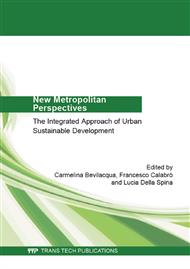p.259
p.267
p.271
p.276
p.282
p.291
p.297
p.303
p.314
Research and Innovation Transfer in the Field of PPP Applied to Urban Regeneration Actions and Policies
Abstract:
The European Union has recognized the centrality of community in economic development processes by stressing the role of the cities in delivering smart, sustainable and inclusive growth. The European Commission has recently published a study on how cities use ERDF to make their cities a better place to live and work [. One of the most engaging results of the study is the variable geometry of strategies in place to achieve urban and territorial cohesion through the implementation of integrated approaches. The area-based type of intervention dominates many of the practices, especially those in deprived areas, because of social, economic and environmental factors. Physical regeneration is still a major driver in creating multi-stakeholder cooperation in the integration of policies. There are relatively few cases in which the place-based approach was combined with a people-based approach and even fewer where ERDF and European Social Fund (ESF) cross-funding was developed [2]. Even the urban dimension in the EU cohesion policy is not a new issue, the way in which the Europe 2020 intends to ensure integrated approach in the sustainable urban development is quite new because it entails both thematic concentration and involvement of the community. According to the Commissions proposals, there are several ways to support sustainable urban development with the Structural Funds: Operational programmes, Integrated Territorial Investment (ITI), Community-Led Local Development, financial instruments (like Jessica and Jeremie) by enhancing new forms of Public Private Partnership. The paper reports some interesting findings of the CLUDs project with respect the role of no-profit organization in different forms of Public Private Partnerships used to regenerate urban districts in the Metropolitan Area of Boston. The research funded by IRSES Marie Curie Actions has created an international network of 4 EU universities (Reggio Calabria, Rome, Salford and Helsinki) and 2 US universities (Northeastern University of Boston and San Diego State University) in research and innovation transfer in the field of PPP applied to urban regeneration actions and policies.
Info:
Periodical:
Pages:
282-290
Citation:
Online since:
June 2014
Authors:
Keywords:
Permissions:
Share:
Citation:


